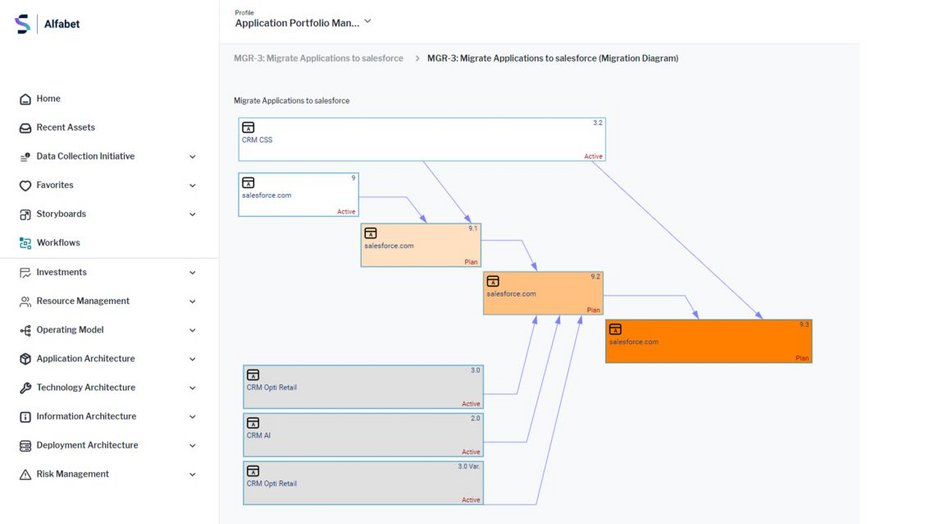Overview
As an Application Portfolio Manager, you're expected to deliver an application landscape that aligns with current business needs and is optimized for cost-efficiency and risk reduction. Additionally, the application landscape should be agile enough to adapt and react to changing business models and market conditions.
Unfortunately, the application landscape is often an uncontrollable behemoth, plagued with redundant functionality, unused applications, and an opaque web of interdependencies. The result: skyrocketing costs, a reluctance to implement change, and an inability to deliver new solutions to meet business demands.
Help is here: Leading international companies use strategic portfolio management (SPM) and enterprise architecture (EA) to ensure that the application landscape is transparent and proactively managed. This approach helps control costs and deliver agility. Interested in learning how?
Gaining control over the application portfolio
Managing the application portfolio effectively requires a clear understanding of which applications you have, what they do, and who uses them. Additionally, you need the right tools to optimize application costs and plan changes to the application portfolio.
Key prerequisites for success include good IT governance and processes that ensure information and KPIs related to applications are available and up-to-date, and that the application portfolio is proactively managed.
However, there are several challenges that must be addressed.
Do you have a reliable system of record for all applications?
You need an accurate and up-to-date inventory of applications. Ownership and management processes should be in place to ensure this accuracy. If not, you cannot manage the application portfolio successfully.
Are the business functions and services provided by the applications documented?
Knowing which organizations, processes, and business capabilities are supported by which applications is critical information for effectively consolidating the application landscape and delivering on business demands.
Can you manage variants and versions of applications?
Are you able to capture indicators such as cost, risk, and user satisfaction and aggregate them for business analysis? Do you have a methodology for portfolio analytics? If not, your application portfolio may be more costly and carry more risks than necessary.
Can you create and manage application roadmaps and life cycles?
Roadmaps and life cycles should be iterative and adaptable for both business and IT needs. Application architecture governance guidelines, policies, and standards should be in place to ensure consistency and viability in planning. If not, creating effective plans becomes a challenge.


Meeting these challenges with SPM and EA
Best-in-class application portfolio managers use SPM and EA to implement the necessary processes and governance into application landscape management and IT planning. By doing this, you can support various stakeholders with core capabilities to meet the challenges of optimizing application portfolios:
- Are applications aligned with business needs?
- Are running costs optimized?
- Is your landscape flexible enough for future business needs?
These key questions are answered by the following essential capabilities.
Application portfolio governance
Application portfolio governance gives you tools to inventory your applications and break them down into manageable portfolios. Application data responsibility and management processes can be implemented. Life cycle management capabilities give planners and strategists the insight they need. Definition and planning of services, information flows, and technologies facilitate projects such as Service-Oriented Architecture (SOA) implementation, data governance, and technology standardization.
IT financial management
IT finance management allows you to allocate costs and budgets to the applications—enabling the analysis of life cycle costs and exposing IT cost drivers in business terms of processes and capabilities. Application portfolios can be optimized for costs, and budget approvals for spending on applications can be managed in accordance with business priorities. This implements better governance and ensures cost effectiveness.
IT planning
IT planning converts business demands into executable and funded IT programs. It enables iterative target application landscapes and scenarios and breaks down roll-out plans and project milestones. Applications are directly associated with projects and demands, enabling impact analysis and exposing conflicts in application roadmaps.
IT risk management
IT risk management enables you to conduct risk assessments on your application landscape to ensure business continuity and compliance. Design, execute, and track risk and controls assessment surveys using consolidated results to drive mitigation strategies
Leader in SPM and EA
Internationally renowned companies across the globe use the market-leading solution for SPM and EA—Alfabet. The platform provides a set of core capabilities to sustainably manage and ensure IT’s contribution to business value. SPM and EA aim to plan and monitor the performance of IT support throughout its entire life cycle—ensuring that business strategy and demands are fully understood, prioritized and executed, and that the costs, quality and risks to IT support are known and considered during decision making.
Right now, we have 10 or more marketing automation applications that fulfill very similar business requirements. We are going to consolidate that down to just 2 or 3. This will happen over a 3-year roadmap, during which costs will temporarily go up as we migrate, train, and integrate. But our costs will get reduced by 50% ultimately. And that’s just one application type.
About Alfabet
Alfabet is a leading enterprise platform with standard modules that support effective Strategic Portfolio Management (SPM) and EA, offering:
- The richest set of artifacts in the industry
- A single, central repository
- Role-based access and support for global communities
- Decision-ready reporting and publication
- Advanced support for the agile enterprise
- Broad and easy-to-use configuration
- Use of leading-edge AI technologies
- Support for federated enterprises



